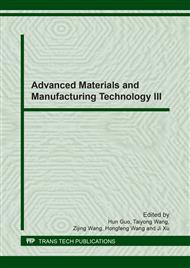p.133
p.142
p.156
p.164
p.174
p.184
p.194
p.201
p.210
Research on Milling Deformation in Ultrasonic Vibration Assisted End Milling of Titanium Alloy Thin-Walled Parts
Abstract:
The hard machinability of titanium alloy material and the poor stiffness of thin-walled parts hindered the extensive application of titanium alloy thin-walled components in aerospace engineering. In order to heighten the geometric accuracy in the processing, the ultrasonic vibration assisted (UVA) end milling technology with workpiece vibrating in feed direction was put forward in this paper, and characteristics of the milling deformation in UVA milling of titanium alloy TC4 thin-walled workpieces were researched. Through the theoretical analysis, the cutting force and deformation characteristics in UVA milling were clarified. Based on the range analysis of orthogonal experiment, the effects of milling parameters and ultrasonic amplitude on the deflection displacement and the milling deformation of workpieces are obtained. Research results show that the deflection displacement in the process of UVA milling affects the thickness error of the thin wall. Ultrasonic parameters as well as milling parameters should be optimized to obtain higher machining accuracy. The research provides a certain reference for the precision milling of titanium alloy thin-walled parts.
Info:
Periodical:
Pages:
174-183
Citation:
Online since:
February 2018
Authors:
Price:
Сopyright:
© 2018 Trans Tech Publications Ltd. All Rights Reserved
Share:
Citation:


